数据关系型图表
沈益
7/29/2019
4.1 带趋势线的散点图
mydata<-read.csv("配套资源/第4章 数据关系型图表/Scatter_Data.csv",stringsAsFactors=FALSE)
ggplot(data = mydata, aes(x,y)) +
geom_point(fill="black",colour="black",size=3,shape=21) +
#geom_smooth(method="lm",se=TRUE,formula=y ~ splines::bs(x, 5),colour="red")+ #(h)
geom_smooth(method = 'gam',formula=y ~s(x))+ #(g)
#geom_smooth(method = 'loess',span=0.4,se=TRUE,colour="#00A5FF",fill="#00A5FF",alpha=0.2)+ #(f)
scale_y_continuous(breaks = seq(0, 125, 25))+
theme(
text=element_text(size=15,color="black"),
plot.title=element_text(size=15,family="myfont",hjust=.5,color="black"),
legend.position="none"
)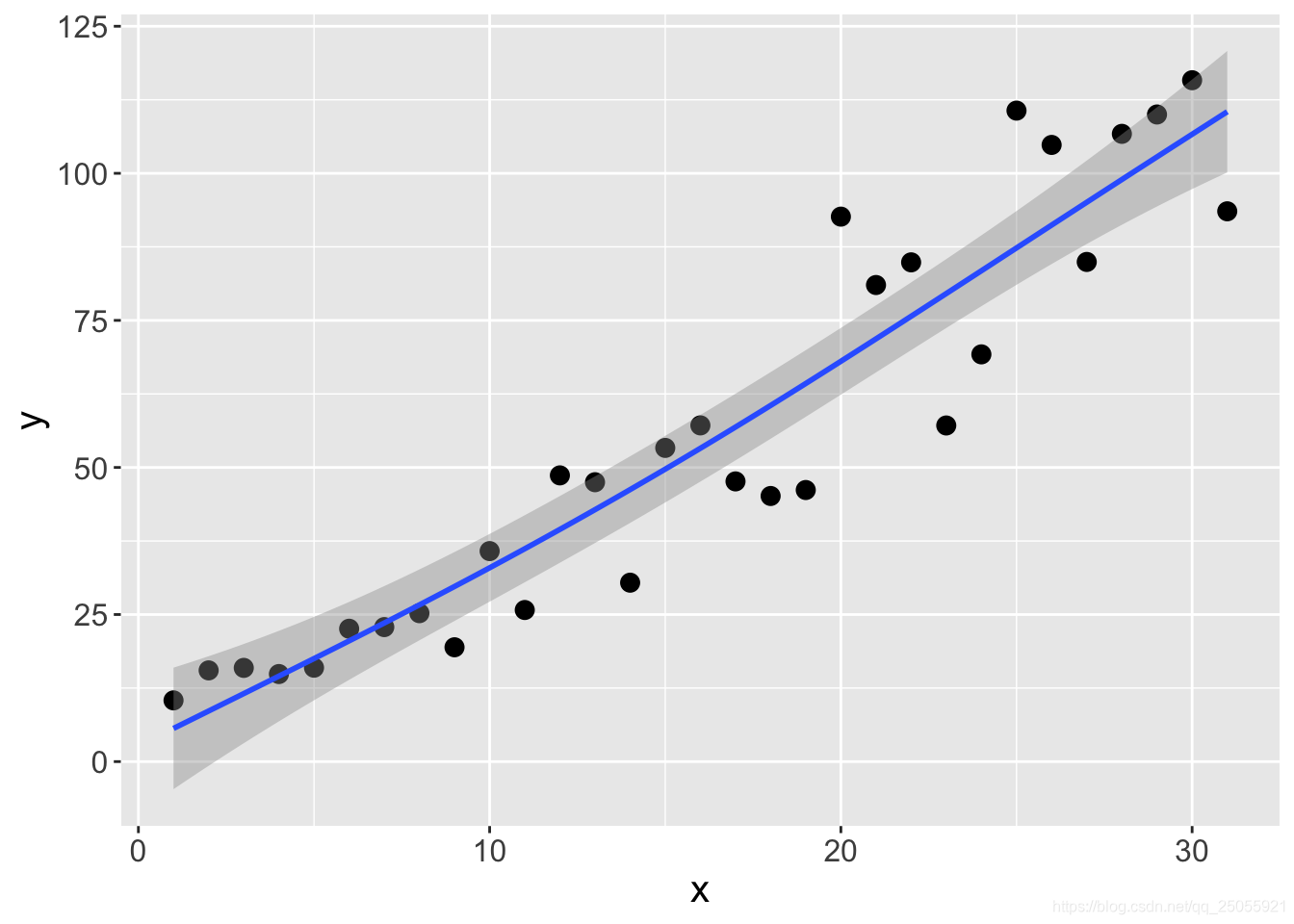
4.2 残差分析图
采用黑色到红色渐变颜色和气泡面积大小两个视觉暗示对应残差的绝对值大小,用于实际数据点的表示;而拟合数据点则用小空心圆圈表示,并放置在灰色的拟合曲线上。用直线连接实际数据点和拟合数据点。残差的绝对值越大,颜色越红、气泡也越大,连接直线越长,这样可以很清晰地观察数据的拟合效果 线性回归
mydata <- read.csv("配套资源/第4章 数据关系型图表/Residual_Analysis_Data.csv", stringsAsFactors = FALSE)
fit <- lm(y2 ~ x, data = mydata) # 对数据进行线性拟合
mydata$predicted <- predict(fit) # 拟合曲线的预测值
mydata$residuals <- residuals(fit) # 拟合曲线的残差值
mydata$Abs_Residuals <- abs(mydata$residuals) # 拟合曲线的残差值的绝对值
ggplot(mydata, aes(x, y2)) +
geom_point(aes(fill = Abs_Residuals, size = Abs_Residuals), shape = 21, color = "black") +
scale_fill_continuous(low = "black", high = "red") + # 修改填充颜色
geom_smooth(method = "lm", se = FALSE, color = "lightgrey") +
geom_point(aes(y = predicted), shape = 1) + # 绘制预测拟合点
geom_segment(aes(xend = x, yend = predicted), alpha = .2) + # 绘制线段
guides(fill = guide_legend((title = "Residual")),
size = guide_legend(title = "Residual")) +
ylim(c(0, 150)) +
xlab("X-Axis") +
ylab("Y-Axis") +
theme(text = element_text(size = 15, face = "plain", color = "black"),
axis.title = element_text(size = 10, face = "plain", color = "black"),
legend.position = "right",
legend.title = element_text(size = 13, face = "plain", color = "black"),
legend.background = element_rect(fill = alpha("black", 0.2)))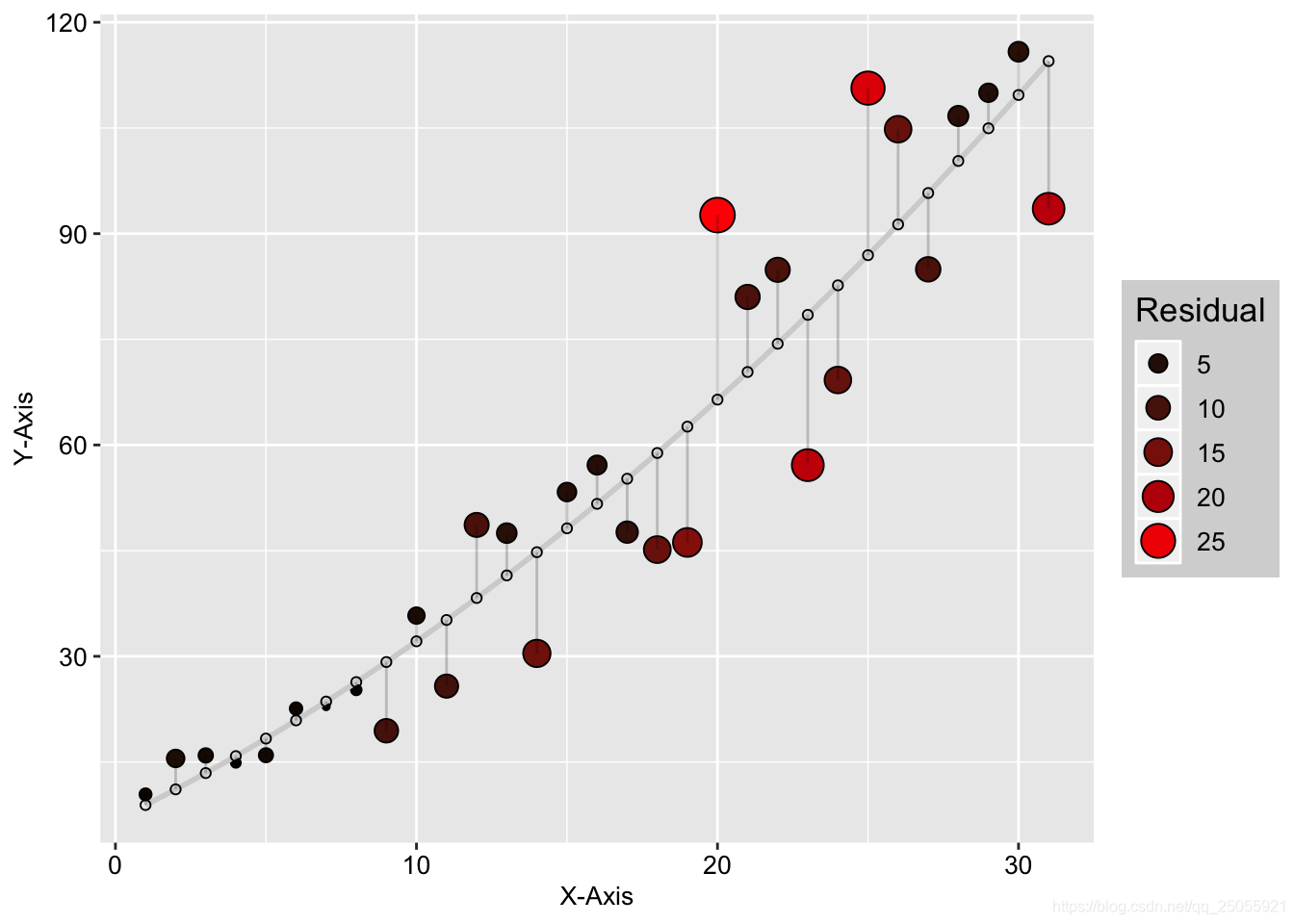
二次回归
mydata <- read.csv("配套资源/第4章 数据关系型图表/Residual_Analysis_Data.csv", stringsAsFactors = FALSE)
fit <- lm(y5 ~ x+I(x^2), data = mydata)
mydata$predicted <- predict(fit)
mydata$residuals0 <- residuals(fit)
mydata$Residuals <- abs(mydata$residuals0)
ggplot(mydata, aes(x, y5)) +
geom_point(aes(fill=Residuals, size = Residuals), shape = 21, color = "black") +
geom_smooth(method = "lm", formula = y ~ x+I(x^2), se = FALSE, color = "lightgrey") +
geom_segment(aes(xend = x, yend = predicted), alpha=0.2) +
geom_point(aes(y = predicted), shape = 1) +
scale_fill_continuous(low = "black", high = "red") +
xlab("X-Axis") +
ylab("Y-Axis") +
guides(fill = guide_legend(title = "Residual"),
size = guide_legend(title = "Residual")) +
theme(text = element_text(size = 15, face = "plain", color = "black"),
axis.title = element_text(size = 10, face = "plain", color = "black"),
axis.text = element_text(size = 10, face = "plain", color = "black"),
legend.position = "right",
legend.title = element_text(size = 13, face = "plain", color = "black"),
legend.text = element_text(size = 10, face = "plain", color = "black"),
legend.background = element_rect(fill = alpha("black", 0.2)))
4.3 直方图
块状直方图
x <- rnorm(250, mean = 10, sd=1) # 随机生成250个,平均值是10,标准差为1的服从正态分布的数
step <- 0.2
breaks <- seq(min(x) - step, max(x) + step, step) # 指定分隔好的区间个数
hg <- hist(x, breaks = breaks, plot = FALSE) # 统计数据频数
bins <- length(hg$counts)
yvals <- numeric(0)
xvals <- numeric(0)
for(i in 1:bins){
yvals <- c(yvals, hg$counts[i]:0) # 每一列有几个数就显示几个方块
xvals <- c(xvals, rep(hg$mids[i], hg$counts[i] + 1))
}
dat <- data.frame(xvals, yvals)
dat <- dat[yvals > 0,]
# colormap <- colorRampPalette(rev(brewer.pal(11, "Spectral")))(32) # 创建梯度颜色
ggplot(dat, aes(x=xvals, y=yvals, fill=yvals)) +
geom_tile(colour="black") +
#scale_fill_gradientn(colours = colormap)
scale_fill_distiller(palette = "Spectral") +
ylim(0, max(yvals) * 1.3) +
theme(
text = element_text(size = 15, color = "black"),
plot.title = element_text(size = 15, family = "myfont", face = "bold.italic", hjust = .5, colour = "black"),
legend.background = element_rect(alpha("black", 0.1)),
legend.position = c(0.9, 0.75)
)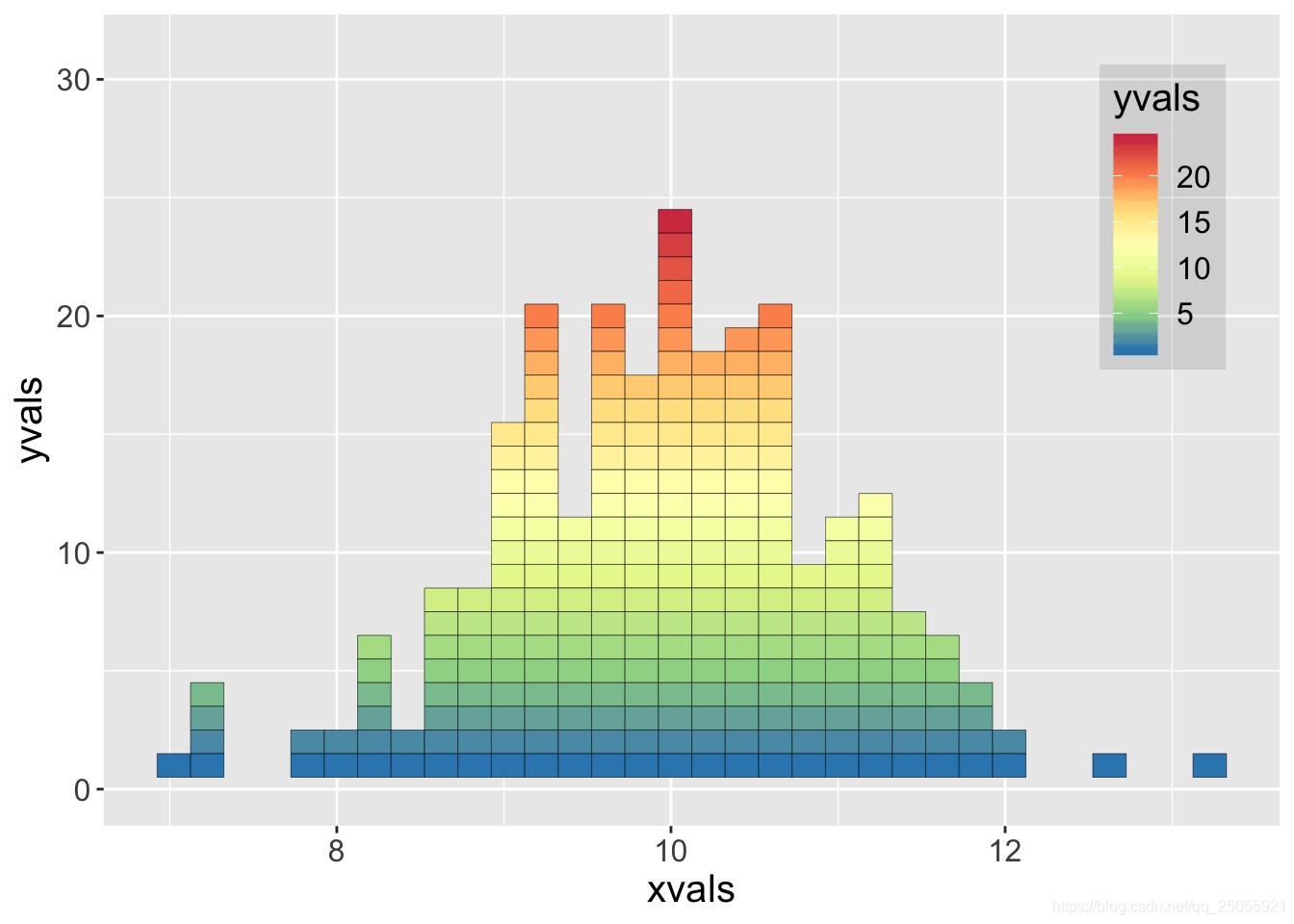
圆圈状点图
x <- rnorm(250, mean = 10, sd=1) # 随机生成250个,平均值是10,标准差为1的服从正态分布的数
step <- 0.2
breaks <- seq(min(x) - step, max(x) + step, step) # 指定分隔好的区间个数
hg <- hist(x, breaks = breaks, plot = FALSE) # 统计数据频数
bins <- length(hg$counts)
yvals <- numeric(0)
xvals <- numeric(0)
for(i in 1:bins){
yvals <- c(yvals, hg$counts[i]:0) # 每一列有几个数就显示几个方块
xvals <- c(xvals, rep(hg$mids[i], hg$counts[i] + 1))
}
dat <- data.frame(xvals, yvals)
dat <- dat[yvals > 0,]
colormap <- colorRampPalette(rev(brewer.pal(11, "Spectral")))(32) # 创建梯度颜色
ggplot(dat, aes(x=xvals, y=yvals, fill=yvals)) +
geom_point(color = "black", shape=21, size = 4) +
scale_fill_gradientn(colours = colormap) +
ylim(0, max(yvals)*1.3) +
theme(
text = element_text(size = 15, color = "black"),
plot.title = element_text(size = 15, family = "myfont", face = "bold.italic", hjust = .5, color = "black"),
legend.background = element_blank(),
legend.position = c(0.9, 0.75)
)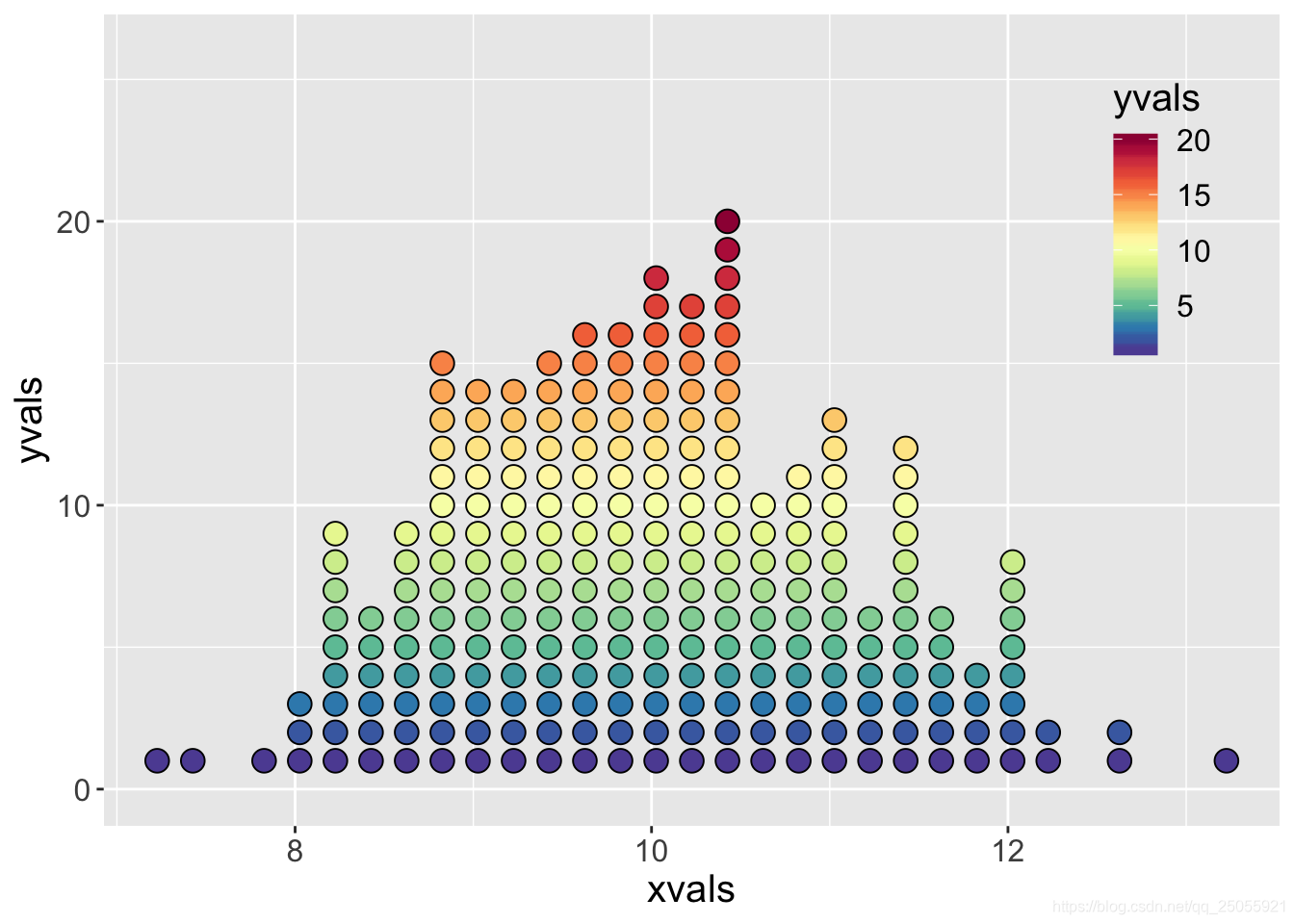
4.4 Q-Q图
P-P图(或 Q-Q 图)可检验的分布包括:beta distribution;t-distribution;chi-squrae;gamma distribution;normal distibution; uniform distribution; Pareto distribution; logistic distributon 一般来说,当比较两组样本时,Q-Q图是一种比直方图更加有效的方法。
df <-data.frame(x=rnorm(250 , mean=10 , sd=1))
ggplot(df, aes(sample = x))+ # qq 图需要制定 sample
geom_qq(shape =1) +
geom_qq_line(fill = "#00AFBB",size=1)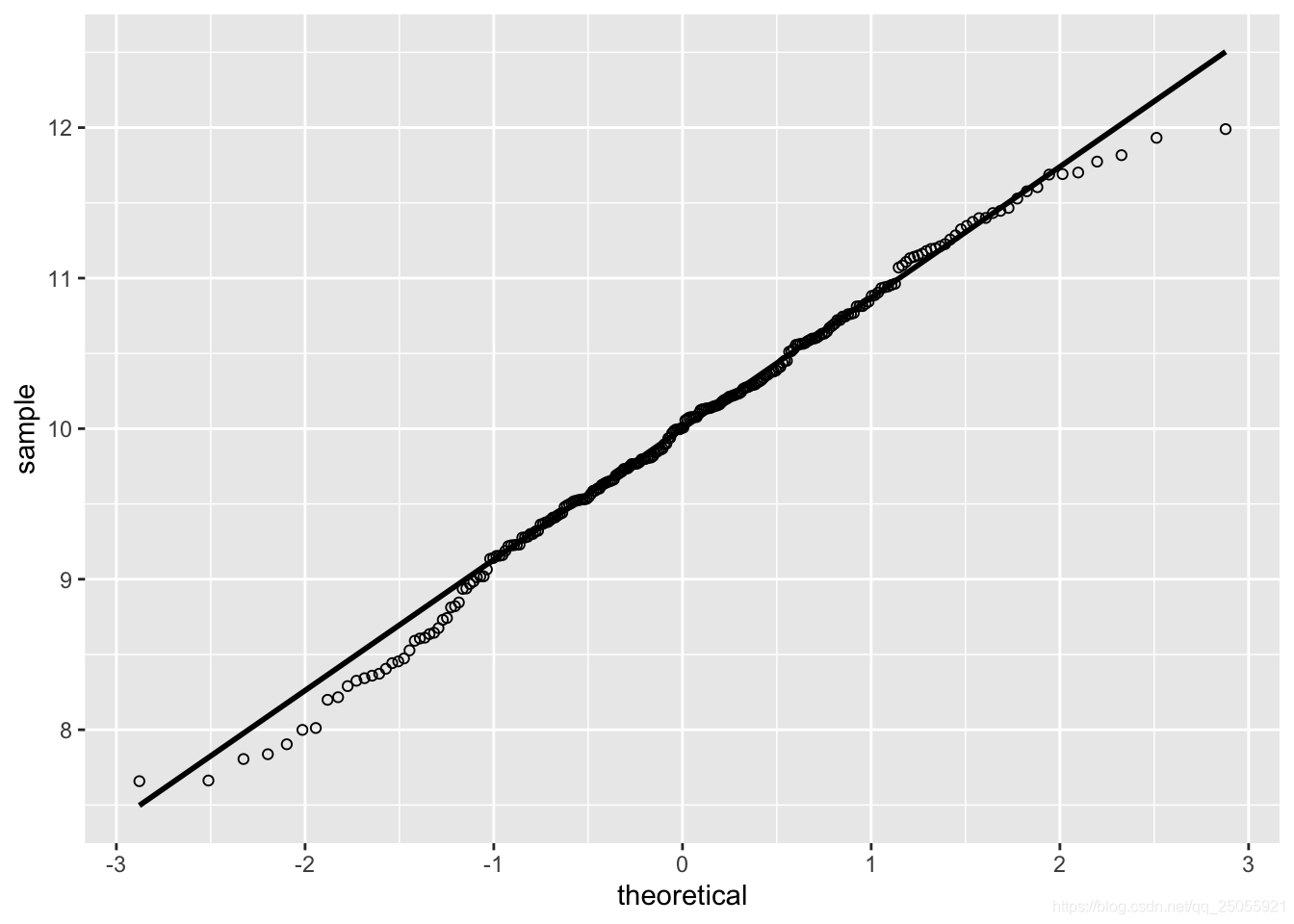
P-P图
library(CircStats)pp.plot(x)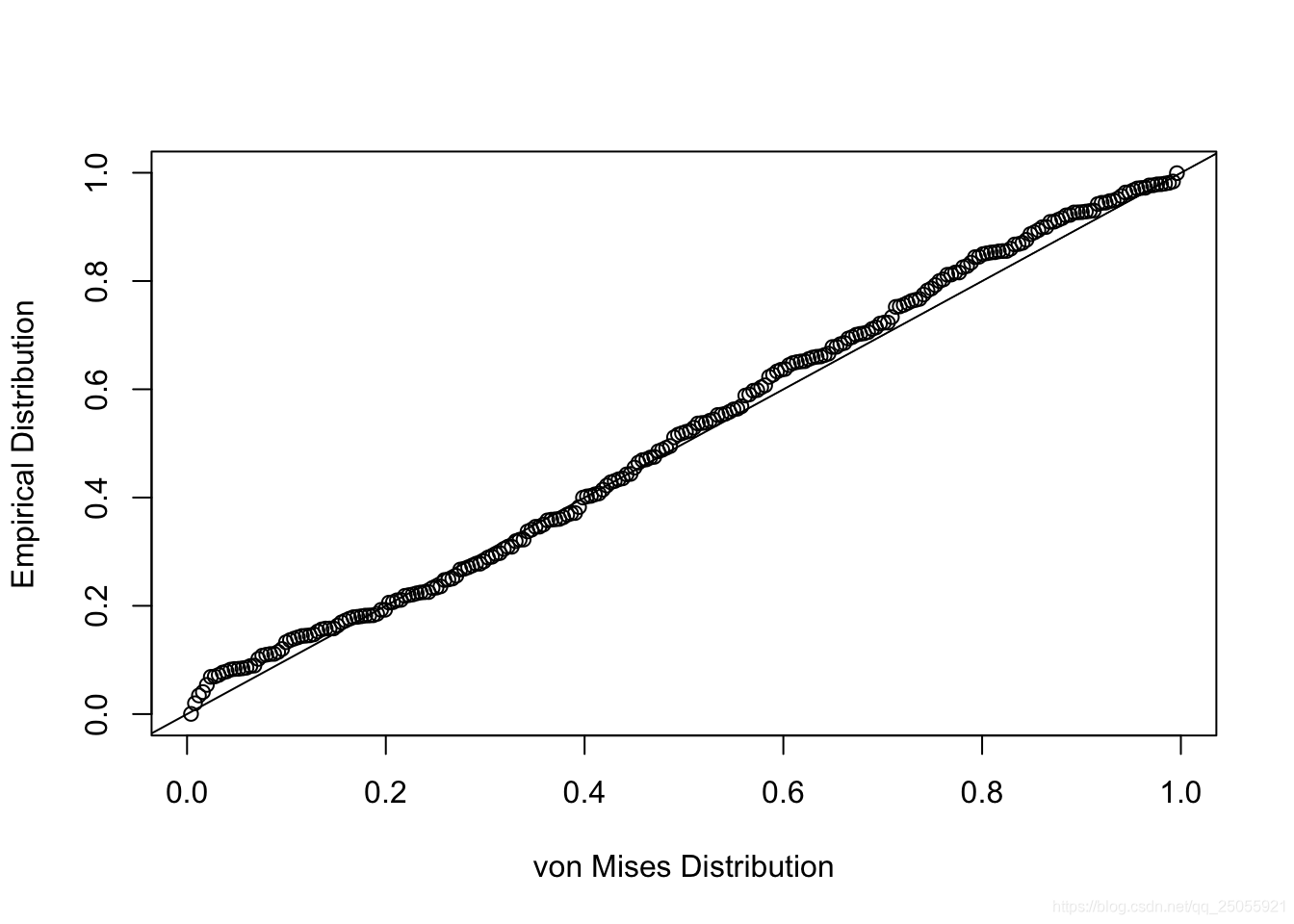
4.5 散点图
散点图通常用于显示和比较数值,不仅可以显示趋势,还能显示数据集群的形状,以及在数据云团中各个点的关系。这类散点图非常适合聚类分析。常用的聚类方法包括 K-means, FCM, KFCM, DBSCAN, MeanShift 等。
带透明度设置的散点图
mydata<-read.csv("配套资源/第4章 数据关系型图表/HighDensity_Scatter_Data.csv",stringsAsFactors=FALSE)
ggplot(data = mydata, aes(x,y)) +
geom_point(colour="blue",alpha=0.2)+ # 设置透明度
labs(x = "Axis X",y="Axis Y")+
theme(
text=element_text(size=15,color="black"),
plot.title=element_text(size=15,family="myfont",face="bold.italic",hjust=.5,color="black"),
legend.position="none"
)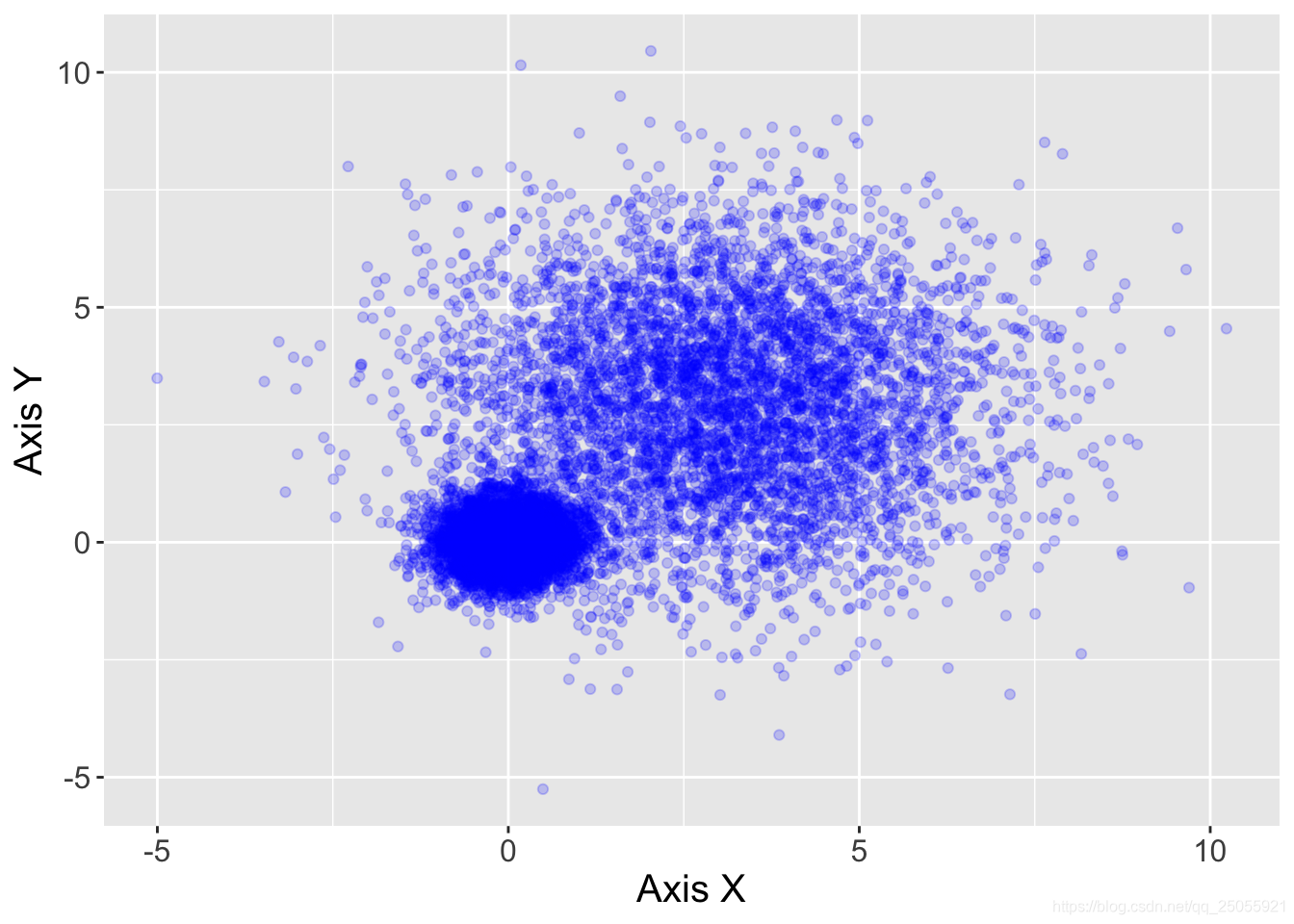
k-means 聚类的散点图
mydata <- read.csv("配套资源/第4章 数据关系型图表/HighDensity_Scatter_Data.csv")
kmeansResult <- kmeans(mydata, 2, nstart = 20) # 聚类的数量为 2,随机数据集选择次数为 200
mydata$cluster <- as.factor(kmeansResult$cluster)
ggplot(mydata, aes(x, y, color=cluster)) +
geom_point(alpha=0.2) +
scale_color_manual(values = c("#00AFBB", "#FC4E07")) +
labs(x = "Axis X", y = "Axis Y") +
theme(
text = element_text(size = 15, face = "bold.italic", color = "black"),
plot.title = element_text(size = 15, face = "bold.italic", color = "black"),
legend.background = element_blank(),
legend.position = c(0.85, 0.15)
)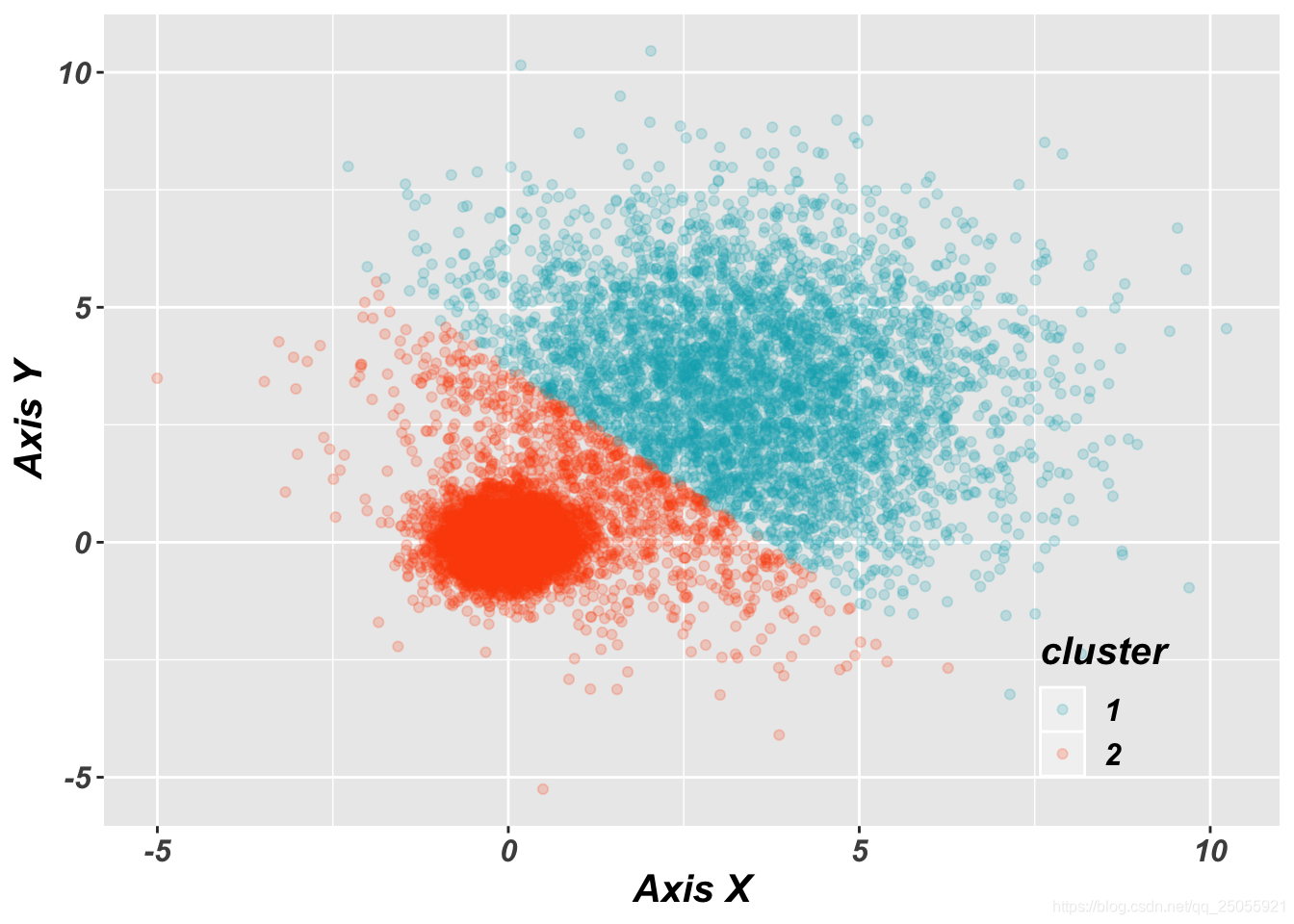
带椭圆标定的聚类散点
mydata <- read.csv("配套资源/第4章 数据关系型图表/HighDensity_Scatter_Data.csv")
mydata$cluster <- as.factor(kmeansResult$cluster)
ggplot(data = mydata, aes(x,y,color=cluster)) +
geom_point (alpha=0.2)+
# 绘制透明度为0.2 的散点图
stat_ellipse(aes(x=x,y=y,fill= cluster), geom="polygon", level=0.95, alpha=0.2) +
#绘制椭圆标定不同类别,如果省略该语句,则绘制图3-1-7(c)
scale_color_manual(values=c("#00AFBB","#FC4E07")) +#使用不同颜色标定不同数据类别
scale_fill_manual(values=c("#00AFBB","#FC4E07"))+ #使用不同颜色标定不同椭类别
labs(x = "Axis X",y="Axis Y")+
theme(
text=element_text(size=15,color="black"),
plot.title=element_text(size=15,family="myfont",face="bold.italic",color="black"),
legend.background=element_blank(),
legend.position=c(0.85,0.15)
)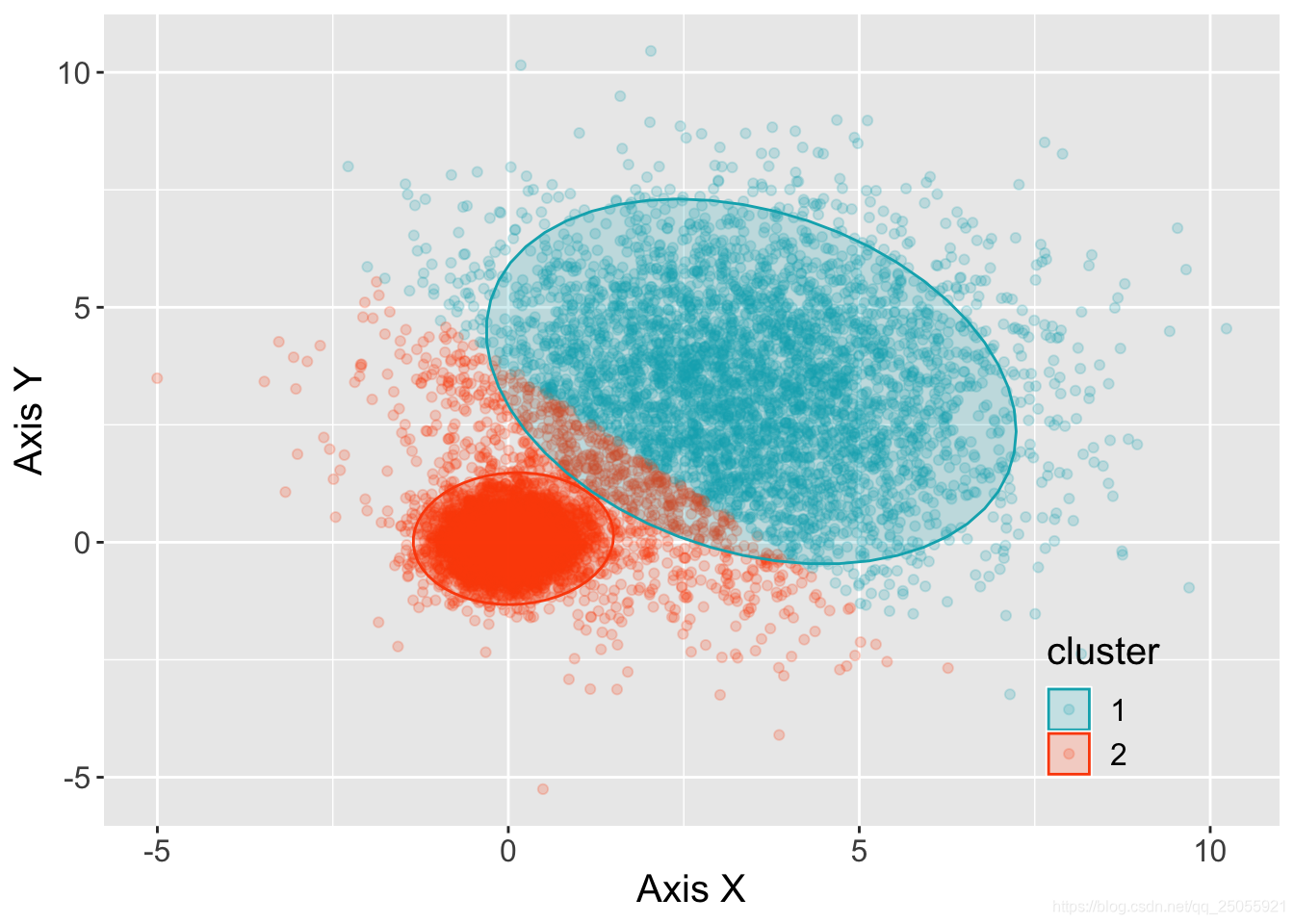
4.6 多数据系列散点图
多数据系列散点图只是在单数据系列上添加新的数据系列,使用不同的填充颜色或者形状区分数据系列,R 中 ggplot2 包中的 geom_point()函数可以根据数据类别映射到不同的填充颜色与形状,以及边框颜色。
mydata <- read.csv("配套资源/第4章 数据关系型图表/HighDensity_Scatter_Data.csv", stringsAsFactors = FALSE)
mydata <- mydata[round(runif(300, 0, 10000)), ]
kmeanResult <- kmeans(mydata, 2, nstart = 20)
mydata$cluster <- as.factor(kmeanResult$cluster)
ggplot(mydata, aes(x, y, fill=clu







 本文详细介绍了使用ggplot2库创建各种数据关系型图表,包括带趋势线的散点图、残差分析图、直方图、Q-Q图、散点图、多数据系列散点图、气泡图、三维散点图、曲面拟合图、等高线图、切面图、三元相图、散点曲线图、瀑布图、热力图、Venn图、树形图、圆堆积图、和弦图和桑吉图,涵盖了数据分析和可视化中的多种常用图表类型。
本文详细介绍了使用ggplot2库创建各种数据关系型图表,包括带趋势线的散点图、残差分析图、直方图、Q-Q图、散点图、多数据系列散点图、气泡图、三维散点图、曲面拟合图、等高线图、切面图、三元相图、散点曲线图、瀑布图、热力图、Venn图、树形图、圆堆积图、和弦图和桑吉图,涵盖了数据分析和可视化中的多种常用图表类型。
 最低0.47元/天 解锁文章
最低0.47元/天 解锁文章
















 1万+
1万+

 被折叠的 条评论
为什么被折叠?
被折叠的 条评论
为什么被折叠?








